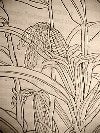
 |
De historia stirpium commentarii insignes. . .adiectis earundem vivis plusquam quingentis imaginibus. . ..
Accessit. . .uocum difficilium & obscurarum passim in hoc opere ocurrentium explicatio. Basileae: In officina Isingriniana, anno Christi 1542. First edition.--Cf. Hunt 48. Names of plants in Latin, Greek, and German. With ports. of the author, the designers, and the engraver. Probably the first book which contains not only the names, but also the portraits of its illustrators. Cf. Klebs no. 72, Includes index. References: Hunt 48; Johnston, S. H. Cleveland coll. 59. Seven preliminary leaves wanting.
This work is one of the most beautiful books printed with full-page illustrations. Special Collections has a three-inch "first field guide" based on this work (See PAT-43). Important in the history of botanical illustration, this is the first early illustrated book to recognize not only the author for his contributions to the project, but also the painter, the transfer draftsman, and the block cutter. One of the best artists in Basel was solicited to prepare the botanical illustrations which even today are respected for their clarity and style. The author, Leonhart Fuchs, deplored the terrible state of medical practice during his lifetime, recognizing that a majority of the practicing physicians did not know their medicines. Most of them relied for information on illiterate apothecaries, who were, in turn, depending upon the peasants who gathered roots and herbs for them. Fuchs realized that patients could easily be poisoned rather than cured because of improper identification of plants. Therefore he compiled this herbal to improve the German pharmacopoeia for the "common man" who was literate but unable to read Latin. While drawing upon the works of Dioscorides, Pliny, and Galen, Fuchs added to his work at least 100 plants not mentioned in earlier herbals. He included many that had been introduced into 16th century Germany from elsewhere, and he tried to ensure that all plants in his work were portrayed accurately. He wanted no mistakes made in their identification. The genus Fuchia was named in his honor. A particularly interesting entry is the first representation of maize (corn), where the text mistakenly refers to the grain as Turkish in origin, rather than American.
Subjects: Botany--Pre-Linnean works; Medicine.
PAT-119